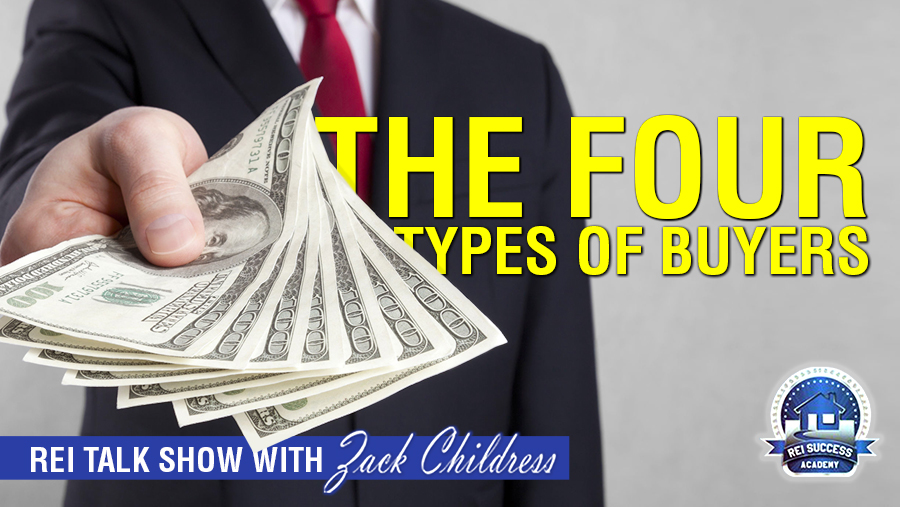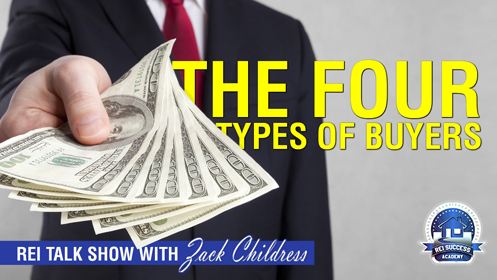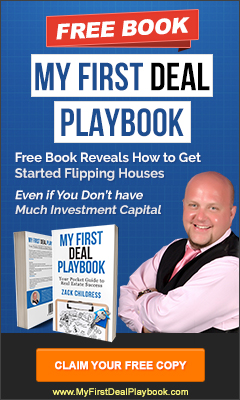
The question that Zack Childress poses in every podcast is how do real estate investors build real wealth and freedom without access to millions of dollars in capital? His mission is to help you find the answer.
Today we’re going to talk about the different types of buyers that you will encounter when working in real estate.
The 1st type is the first-time buyer. They’re good candidates for fix and flips because they’re usually looking for a low price.
They’ve got a down payment, and generally use standard bank mortgages. Occasionally they need seller financing, which gives you a higher return.
Listen to learn about other types of buyers, including financed investor buyers, cash buyers and tenant buyers. Zack breaks the larger categories into smaller units for an enlightening level of detail.
“You can’t expect your results in life to change if you continue doing the same thing.”
Watch and learn:
Listen and enjoy:
What’s inside:
- Seller financing
- Early on, stick with cash buyers
- Sell to other wholesalers
- Find financed investors in your market
Mentioned in this episode:
- Reach Zack by phone: 707.247.4248
- Follow Zack on Facebook: REI Success Academy Facebook
- Zack’s Book: My First Deal Playbook
- Zack’s course: The Quick Cash Quadrant System
Transcription:
Download episode transcript in PDF format here…
So, the big question is this, how do aspiring real estate investors like us escape from the rat race and build real wealth and freedom without access to millions of dollars in investment capital and start to live the life that we know we deserve? This is the question and this podcast will give you the answer. My name is Zack Childress and welcome to Real Estate Investing Talk Show.
Zack Childress: So, there’s four key buyers in the real estate space or in the real estate business that we’re in of investing. And we’re going to talk about the very first one is our first-time buyers. And this is for like if you’re out there and you’re going to be doing the fix and flip model, you’ve got to be going after first time buyers, right. These are buyers that are coming out of the apartment complex, is moving into a house. They’re getting qualified from a bank. You’re there, you’re straight or you’re standard type buyers. They’re FHA there, you know the coming in with a down payment and they’re going to live there and put a 30-year mortgage on the property. We sell our fix and flips to those types of buyers, you know, because if you’re doing fix and flip, you should be doing them in a market that is catering to first time buyers. They’re the largest buyer pool for our first-time buying homes is first time buyers. I don’t know if that came out right, but.
Zack Childress: Most of your average home sells prices is going to be the largest pool of sells in your market. The average home sells price. That largest pool is your first-time buyers. It’s the easy entry home prices. That next market, it’s one 60, one 70, somewhere in there. That next level, that second time buyer that upgrade, they go into the to 225 to 300 range. That will just say two to 300 range. They go from this level on into the two to 300. That’s not a first-time buyer market. That’s the second time buyer. So, now are there some first-time buyers that go right into that? Yeah, there are. They rented, they’ve got great jobs, they’ve saved up a lot of money.
Zack Childress: They’re going in there buying a $300,000 house, they’re putting $60,000 down, you know, their financing 240 and that’s what they want and so they do it. But also, under the first-time buyer pool. Let’s talk about this. There’s, there’s two actually underneath, there’s the standard buyer, but there’s also the seller financed buyer, right? So this would be like if you’re in the seller financing business, so if you’re in the business of buying properties for 80,000, let’s just say put in 15 into them, getting them nice and getting them looking decent, and then you’re selling that property with seller financing and this is typically for the first time home buyer that just doesn’t have the credit or the ability to go through a bank. So, you’re stepping in as a lender and you’re maximizing your, your dollars because if you think about it, if you, let’s say you bought it for 80, put 15 into it, your 100 grand in let’s just say it’s worth 140, okay.
Zack Childress: It’s a first-time home buyer, you know, nice little niche. If you sold it for 140, you might make $25,000 profit off of it, maybe, maybe 20, 25 off of it. But if you sold it on seller financing, not only you get the payments off of it every month, but if you, let’s say you did a 15 year note on it, you would end up making not 140 as a sales price, but you’d end up somewhere around 225 to 240, somewhere in there. Because of the amortization schedule. So, if you have the ability for the long-term wealth off that model, you make a lot more because it’s front end interest heavy. They don’t even start paying on the principal until about halfway into the program. So, so that one falls under it as well. Okay.
Zack Childress: Now there’s the other type of buyer. So, buyer number two, buyer number one is first time buyers. We got two ways of doing it, just a straight sale or a seller financing to them. Buyer number two is are financed buyer, right. Now this is investor finance. Okay. Let me be very clear, not first-time buyer, but our investor financed buyer. Okay. This is an investor who’s getting financing from a bank to buy fix and flips or financing from a bank to go out and buy rental properties. As a wholesaler, you overlook these buyers because you’ve been taught to only sell to a cash buyer. Well, I don’t know why. Well, yeah, I do know why, because that’s what everybody and their brother teaches out there, but that’s not the only way to wholesale, is just a cash buyer. I have an incredible course called The Quick Cash Quadrant System. Okay.
Zack Childress: And this is a wholesaling course that breaks down the four different ways to wholesale properties, not just cash buyers, but traditional co-option and finance wholesaling and it talks about the different ways in the different buyers that are available to you so that you can really become a master wholesaler. And that’s what’s so important about understanding these extra buyers in your business model. So, when you’re dealing with a financed invest by investor buyer, you opened up a whole another world, a whole other world of buyers, and we can. And people will say, well, how do you wholesale to them? Well, you can either wholesale to them using a demand of funds letter, which allows them to go into a direct contract which allows the investor buyer to have a contract with the seller so they can actually close, or you got to do a back to back type closing.
Zack Childress: So, either way, that’s a buyer number two, you’re financed buyer. I guarantee you your competition is not targeting these buyers. I guarantee it. That’s what I say. I guarantee it, guarantee it. That’s what I’ll tell you that right now. I’ll tell you that every time. I’ll tell you, I’ll tell you, I’ll tell you until I can’t tell you no more, okay. So alright buyer number three, this is the one everybody knows. It’s your cash buyer. Your cash buyer is probably, as a wholesaler, it’s going to be 70 percent if not 80 percent of all your transactions. Okay? A cash buyer. Until you start getting a little more sophisticated and you start getting a little bit more aware of the financed buyers in your market and how to work with those financed buyers. As a wholesaler that’s a goldmine for you.
Zack Childress: If you’ve ever been to any of my live events, you know, I teach this strategy, I teach it to the core to get you guys moving in a direction that you’re not just doing the same thing every other wholesaler is doing so that you can try to be different in your approach. But yes, 70 to 80 percent of all your wholesale transactions are going to be with a cash buyer until you line in your finance buyer, investors. Okay? So, tier one, let’s talk about your buyers. Yeah, I’ve got a fourth one to share with you, but I’m just going to break it down by strategy for you. Tier one wholesaler, you should be catering to three types of buyers. Okay. Well, I mean given you the third one yet. So, let me just back up. Let me go ahead and give you the fourth buyer.
Zack Childress: The fourth buyer is your tenant buyer. That’s your tenant buyer. The tenant buyer is the buyer that you’re doing like tier two strategies. You’re doing creative financing with your leasing, with the option to buy to them. You’re, you’re turning them into a buyer over time. It’s kind of like the seller financing buyer when we’re fixing up properties and selling them on seller financing, but we, you don’t have to fix them up all the time on a sandwich lease option where we’re targeting a tenant buyer, we can put handyman special. Your job is your credit. Why rent when you can own and they know they’re walking into it. So, let’s talk about this. So, in care, our tier one strategy wholesaling, you have three buyer types inside of that alone. Well really you got four. You’ve got your tenant buyer, which means if I take, if I’m looking at a wholesale deal, the has no equity in it and there’s no cash flow to be made on it. I’m going to wholesale that deal to a tenant buyer. You have your cash buyer, which means I’ve got a wholesale contract and it’s a good deal for a rehabber, so I’m going to sell that contract to a cash buyer and I’m going to make my assignment theme.
Zack Childress: You have your financed buyer, which means I’ve got a deal under contract, that’s a good deal and I’ve got a buyer who wants it and he’s getting financing so I can work with him. So, I will then either DOF the transaction or double close to get that financed by on the deal. Okay. And the number four in wholesaling is really other wholesalers where I am bringing my contract to another wholesaler and then they’re selling it for me. So, there’s four main buying types when you look at it that way as a wholesaler. Okay. So, wholesaler you should be working with for buyers as a wholesaler. Okay. Then we move into creative financing. Creative financing is anything like lease options, contract for deed, land installment contract wrap mortgages, subject to straight line financing. Any of that stuff is a creative financing.
Zack Childress: In creative financing we have to buyer types, right? We have the tenant buyer and we have the seller financed buyer, right, which kind of fall into the same category, but that’s your two buyer types in that type of world. Well actually there’s three, investor. So, you have tenant, buyer, seller financing, and the investor because why? If I structure a seller financing deal that I just don’t want to do anything with it, I could flip or sell or assign my contract to another investor and they could step in on the seller financing and they themselves could take on that seller financing transaction and work with the tenant buyer or the seller financed buyer. So, when you’re dealing with creative financing, whether it be any of them, contract for deed, land installment, wrap, mortgage, subject to lease options, straight line, any of those. There’s really three buyers in there which we talked about them, right?
Zack Childress: Seller financing, lease option, which the seller financing is your first-time buyer. The first-time buyer is really either a financed, is a buyer getting financing or you’re offering seller financing. So, it is that buyer a tenant buyer or an investor. So, you’ve got three buyers for your tier two strategy. Okay, so now let’s move into tier three. Tier three is fixing flips, right? It’s we’re fixing the property up, we’re getting it ready for sale and we’re selling it. What does that mean? That means who’s our buyer, right? It’s all about, today’s all about who’s your buyer. So, in a fix and flip transaction, our buyer is always going to be the first-time buyer in most cases. 90 percent of the time it’s the first-time buyer. That first-time buyers tired of their apartment, they’re tired of the neighbors, they want their own house.
Zack Childress: If we’re fixing and flipping properties, we should be doing them. And the average sales price neighborhoods, which is where first time buyers buy, right? So, our target buyer for fix and flip is our first-time buyer. Now if I for some reason can’t sell that property because I didn’t follow my Zack’s training, I didn’t get Zack’s book, I didn’t. I don’t understand segmentation or clustering. Then you bought a property somewhere that can’t sell. Will your only other exit with that is either to rent it. Which we don’t want to do that, right, because then they’re going to destroy the property, they’re not going to take care of it. That’s like last resort. We’re going to rent it until we can sell it. Or I could simply move it from a first-time buyer, which we talked about earlier, to a seller financing buyer, okay. That buyer is their ability to execute their close, has everything to do with your ability to actually offer them financing. If for some reason you couldn’t sell it, okay.
Zack Childress: And that’s going to have everything to do with how you acquired the property based on the acquirement of the financing to get the property. Okay? So, if you use some type of asset or hard money lending and they were only willing to do a six-month loan with the rights to extend for six months, that means you got 12 months. That really means that seller financing could only be 12 months deal even if you have 12 months left. Right? So that’s the problem with that is that financing. So, you would need to go get that property refinanced into some stable loan with a traditional bank so that you could offer that seller financing. If not, you got yourself in a pickle and listen, it happens all the time. It happens all the time. So that’s number three.
Zack Childress: So, then that takes us into number four, which number four is really buy and hold tier four buy and hold, which we don’t, we don’t need a buyer for buy and hold. I mean, I mean, goodness gracious, I don’t buy rental properties to sell them, right? I buy rental properties to rent them to people so that I can make cash flow. So that I can live a lifestyle that I want with my kids and take care of all my obligations and all the bills I have to pay. Right? You know, I take care of two families pretty much. And so, you know, I want rental properties. I want rental properties, more and more rental properties, more and more rental properties. That’s the key. That’s wealth building, that’s building a strategic plan to get you to a level of comfort. I’m not saying go quit your job.
Zack Childress: I don’t tell people to do that at all. Now I got a lot of success stories where people tell me they’ve quit their job because of what we’ve been teaching them, but I’m not telling you to quit your job because here’s why. If you’ve got a job that you love and let’s just say you’re making 30, 40, 50, $60,000 a year, I don’t know what you make, but you’re happy there. Well, imagine building rental portfolio on the side and now you’re starting to make you know, two, three, $4,000 a month extra on your rental portfolio. Let’s say you’re making $4,000, $3,000 a month in your rental portfolio. That’s $36,000 extra a year on top of what you’re making. So, if you’re making 40, now you’re making almost $80,000 a year and half of it’s passive. That’s what you got to think about. That’s why we do you understand.
Zack Childress: That’s why we do tier one, tier two, tier three. That’s why we fix and flip. That’s why we wholesale. That’s why we do creative financing. To get deals so that we can make money to sell those deals and make money off of them so that we can then go buy rental property. So, we can buy houses if that’s what you want to do to get started. Or we can go buy duplexes, triplexes, fourplexes, eight. 10 units, 20 units, 40 units, 50 units. It doesn’t matter. The point is, is building wealth. You’re not going to build wealth doing what you’ve always done. If you want to get something different out of your life, you’ve got to do something different. It’s the key. You can’t expect new results doing the same thing you’ve always done.
Zack Childress: Listen, when it comes to business, I get this. When it comes to other parts of my life, I don’t get it right. Somebody said to me the other day, well, it’s like you’re so successful in business, you know, why aren’t you that same success in your health. I feel like I’m pretty healthy. I just, you know, I like to eat food, but I’m not changing my habits or I would get different results. So, buy and hold your buyer is not really a buyer back to it. It’s a rental. It’s a rental. It’s a renter, right. So, we need rental people in there. But if I didn’t want to be a landlord, let’s just, let’s just listen to me here. Listen to me here. If I had rental properties, but I didn’t want to be a landlord. Okay. Let’s just say like, I didn’t want to have to fix toilets or change lights or I didn’t want to have to deal with any of that stuff. Okay.
Zack Childress: Then I wouldn’t put a renter in my property. I would put a tenant buyer in that property or I would put a seller financing person in that property and here’s why. Because they are going to basically rent to own that property. But the beauty of doing it in like a tenant buyer position or a seller financing position means that I’m not a landlord. I’m acting as a bank in that, in that scenario. And I’m not coming to fix things. I’m not coming to fix a toilet or a broken window or a locked that’s got a key broken off into it. I’m not doing all that and if that language is very clear in the contract and in the dialogue that we have with the person that I’m doing the financing for. So that’s a scenario that you might want to look at too. But that does require you to liquidate the property if they qualify to buy it. So that’s something that you know, that’s the good and the bad. The good is, is it’s like owning rental properties without any headaches. The bad is you got to sell the rental property at one point when they qualify, so.
You’ve been listening to the Real Estate Investing Talk Show. I’m Zack Childress and I’m on a mission to create 10,000 real estate bosses over the next year. Will you be one of them?
Head over to my website, ReiSuccessAcademy.com/webclass, and register for my free web class, where you’ll discover how to escape from the nine to five grind and become your own boss in real estate. See you there.









